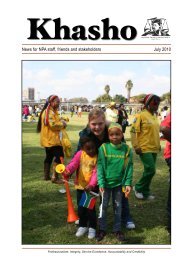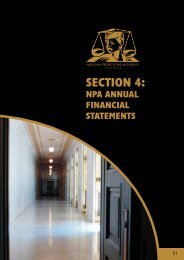Uniform Protocol for the Management of Victims, Survivors and ...
Uniform Protocol for the Management of Victims, Survivors and ...
Uniform Protocol for the Management of Victims, Survivors and ...
You also want an ePaper? Increase the reach of your titles
YUMPU automatically turns print PDFs into web optimized ePapers that Google loves.
Continued from page 2<br />
such as <strong>the</strong> National Crime Prevention Strategy<br />
(NCPS) (May 1996) which, promoted a victimcentred<br />
approach to crime prevention, placing <strong>the</strong><br />
onus on government to deliver a crime prevention<br />
strategy central to <strong>the</strong> rights <strong>and</strong> needs <strong>of</strong> victims.<br />
It fur<strong>the</strong>r acknowledged that victimisation lies at<br />
<strong>the</strong> heart <strong>of</strong> much retributive crime <strong>and</strong> that <strong>the</strong><br />
absence <strong>of</strong> means <strong>of</strong> victim aid <strong>and</strong> empowerment<br />
plays an important role in <strong>the</strong> nature <strong>of</strong> violence<br />
<strong>and</strong> crime in South Africa. Accordingly a<br />
national programme <strong>for</strong> victim empowerment was<br />
included in <strong>the</strong> activities <strong>of</strong> <strong>the</strong> NCPS.<br />
Historically, even be<strong>for</strong>e <strong>the</strong> dawn <strong>of</strong> <strong>the</strong> South<br />
African democratic era, government did not focus<br />
on issues <strong>of</strong> violence against women <strong>and</strong> children.<br />
On <strong>the</strong> o<strong>the</strong>r h<strong>and</strong> <strong>the</strong> key players who always<br />
had <strong>the</strong> interest <strong>of</strong> victims at heart <strong>for</strong> service<br />
delivery in this area was <strong>the</strong> civil society.<br />
In answering <strong>the</strong> call to a victim centred approach<br />
in service delivery, as heralded by <strong>the</strong> NCPS,<br />
government has in collaboration with civil society<br />
undertaken to uphold, protect, <strong>and</strong> respect <strong>the</strong><br />
rights <strong>and</strong> needs <strong>of</strong> victims <strong>of</strong> domestic violence<br />
<strong>and</strong> sexual <strong>of</strong>fences as <strong>the</strong>y engage <strong>and</strong> beyond<br />
exiting <strong>the</strong> Criminal Justice System (CJS).<br />
Research 3 has shown that many victims <strong>of</strong> crime<br />
that engage <strong>the</strong> CJS were not as anxious about<br />
<strong>the</strong> case itself. Instead <strong>the</strong>y had a greater fear<br />
about <strong>the</strong> unknown territory that would await<br />
<strong>the</strong>m when <strong>the</strong>y engage <strong>the</strong> system. It fur<strong>the</strong>r<br />
revealed that where a victim was treated with<br />
dignity <strong>and</strong> respect upon engaging <strong>the</strong> CJS, <strong>the</strong>y<br />
had a greater sense <strong>of</strong> confidence in <strong>the</strong> system<br />
<strong>and</strong> in service providers.<br />
Government has realised that <strong>the</strong> failure to treat<br />
victims with dignity, respect <strong>and</strong> underst<strong>and</strong>ing <strong>of</strong><br />
<strong>the</strong> dynamics <strong>of</strong> <strong>the</strong>se <strong>of</strong>fences results in<br />
secondary victimisation, which has thus far been<br />
prevalent in <strong>the</strong> South African Criminal Justice<br />
System. Secondary victimisation has been a<br />
phenomenon that has continued to deprive victims<br />
<strong>of</strong> domestic violence <strong>and</strong> sexual <strong>of</strong>fences <strong>of</strong> <strong>the</strong><br />
much-needed legal protection that <strong>the</strong> laws <strong>of</strong><br />
South Africa particularly <strong>the</strong> Constitution<br />
af<strong>for</strong>ds <strong>the</strong>m.<br />
The CJS continues to have an alarming number <strong>of</strong><br />
case withdrawals by complainants <strong>and</strong> a low<br />
reporting rate by victims. This is partly because<br />
<strong>of</strong> <strong>the</strong> fact that <strong>the</strong>y undergo secondary<br />
victimisation when engaging <strong>the</strong> system.<br />
As evidenced by <strong>the</strong> need to address secondary<br />
victimisation, several service providers have<br />
translated this need into various positive interv e n-<br />
tions, which however lack consistency <strong>and</strong><br />
u n i f o rmity that leads to fur<strong>the</strong>r imbalances in<br />
<strong>the</strong> treatment <strong>of</strong> victims. These imbalances include<br />
i n ter alia <strong>the</strong> unequal treatment <strong>and</strong> ineff i c i e n t<br />
s e rvice delivery to victims.<br />
Accordingly <strong>the</strong>re is a need to create uni<strong>for</strong>mity in<br />
service delivery in order to inter alia address <strong>the</strong><br />
issue <strong>of</strong> secondary victimisation <strong>and</strong> to ensure<br />
effective service delivery to <strong>the</strong>se victims.<br />
This approach would include <strong>the</strong> need <strong>for</strong><br />
supportive services that are appropriate, in<strong>for</strong>mative<br />
<strong>and</strong> accessible to victims that will ensure <strong>the</strong><br />
equal protection <strong>of</strong> <strong>the</strong>ir constitutional rights<br />
throughout <strong>the</strong> CJS.<br />
This necessitates <strong>the</strong> establishment <strong>of</strong> a coord i n a t e d<br />
approach <strong>and</strong> referral system that will regulate<br />
Victim Assistance <strong>and</strong> Preparation (VAP) services<br />
<strong>and</strong> <strong>the</strong>reby ensure uni<strong>for</strong>mity <strong>and</strong> quality control<br />
<strong>of</strong> <strong>the</strong>se services <strong>and</strong> service providers.<br />
The development <strong>and</strong> implementation <strong>of</strong> <strong>the</strong>se<br />
Minimum St<strong>and</strong>ards is <strong>the</strong>re<strong>for</strong>e a collaborated<br />
ef<strong>for</strong>t by service providers with <strong>the</strong> intention <strong>of</strong><br />
af<strong>for</strong>ding equal protection to everyone affected<br />
by <strong>the</strong>se crimes. These st<strong>and</strong>ards ensure that <strong>the</strong><br />
victim is journeyed through <strong>the</strong> system <strong>and</strong> in <strong>the</strong><br />
process empowered <strong>and</strong> supported until he or she<br />
becomes a survivor <strong>of</strong> violence.<br />
3<br />
Study conducted by <strong>the</strong> Institute <strong>for</strong> Security Studies as commissioned by <strong>the</strong> National Prosecuting Authority in 2002<br />
3

















